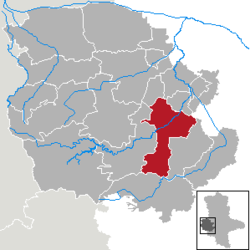Quedlinburg
| Quedlinburg | ||
|---|---|---|

Quedlinburg castle hill
|
||
|
||
| Coordinates: 51°47′30″N 11°8′50″E / 51.79167°N 11.14722°ECoordinates: 51°47′30″N 11°8′50″E / 51.79167°N 11.14722°E | ||
| Country | Germany | |
| State | Saxony-Anhalt | |
| District | Harz | |
| Government | ||
| • Mayor | Frank Ruch (CDU) | |
| Area | ||
| • Total | 120.42 km2 (46.49 sq mi) | |
| Population (2015-12-31) | ||
| • Total | 24,555 | |
| • Density | 200/km2 (530/sq mi) | |
| Time zone | CET/CEST (UTC+1/+2) | |
| Postal codes | 06484, 06485 | |
| Dialling codes | 03946, 039485 | |
| Vehicle registration | HZ, HBS, QLB, WR | |
| Website | www.quedlinburg.de | |
| Collegiate Church, Castle, and Old Town of Quedlinburg | |
|---|---|
| Name as inscribed on the World Heritage List | |

South of the castle hill: Schlossmühle
|
|
| Location | Germany |
| Type | Cultural |
| Criteria | iv |
| Reference | 535 |
| UNESCO region | Europe and North America |
| Inscription history | |
| Inscription | 1994 (18th Session) |
Quedlinburg (German pronunciation: [ˈkveːdlɪnbʊʁk]) is a town situated just north of the Harz mountains, in the district of Harz in the west of Saxony-Anhalt, Germany. In 1994, the castle, church and old town were added to the UNESCO World Heritage List.
Quedlinburg has a population of more than 24,000. The town was the capital of the district of Quedlinburg until 2007, when the district was dissolved. Several locations in the town are designated stops along a scenic holiday route, the Romanesque Road.
The town of Quedlinburg is known to have existed since at least the early 9th century, when there was a settlement known as Gross Orden on the eastern bank of the River Bode. It was first mentioned as a town in 922 as part of a donation by King Henry the Fowler (Heinrich der Vogler). The records of this donation were held by the abbey of Corvey.
According to legend, Henry had been offered the German crown at Quedlinburg in 919 by Franconian nobles, giving rise to the town being called the "cradle of the German Reich".
After Henry's death in 936, his widow Saint Matilda founded a religious community for women ("Frauenstift") on the castle hill, where daughters of the higher nobility were educated. The main task of this collegiate foundation, Quedlinburg Abbey, was to pray for the memory of King Henry and the rulers who came after him. The Annals of Quedlinburg were also compiled there. The first abbess was Matilda, a granddaughter of King Henry and St. Matilda.
The Quedlinburg castle complex, founded by King Henry I and built up by Emperor Otto I in 936, was an imperial Pfalz of the Saxon emperors. The Pfalz, including the male convent, was in the valley, where today the Roman Catholic Church of St. Wiperti is situated, while the women's convent was located on the castle hill.
...
Wikipedia



